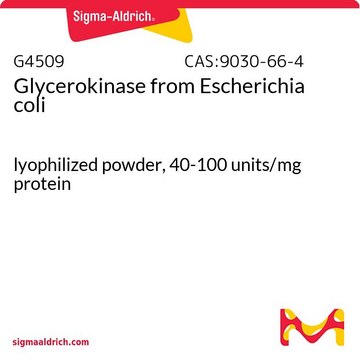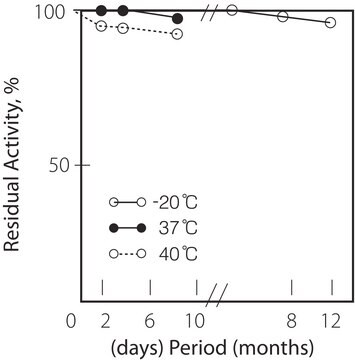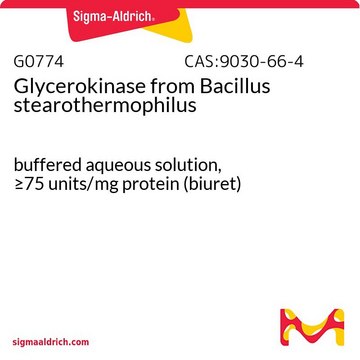G6278
Glycerokinase from Escherichia coli
300-600 units/mL, ammonium sulfate suspension
Sinónimos:
ATP:glycerol 3-phosphotransferase, Glycerol Kinase
Iniciar sesiónpara Ver la Fijación de precios por contrato y de la organización
About This Item
Productos recomendados
biological source
Escherichia coli
Quality Level
form
ammonium sulfate suspension
concentration
300-600 units/mL
storage temp.
2-8°C
¿Está buscando productos similares? Visita Guía de comparación de productos
General description
Research Area: Cell Signaling
Glycerol kinase (GK) is a member of the FGGY carbohydrate kinase family (ATP: glycerol 3-phosphotransferase), which is responsible for transferring a phosphate group from ATP to glycerol.
Glycerol kinase (GK) is a member of the FGGY carbohydrate kinase family (ATP: glycerol 3-phosphotransferase), which is responsible for transferring a phosphate group from ATP to glycerol.
Application
Glycerol kinase (glpK) was used to study the effects of pain controlling neuropeptides on human fat cell lipolysis.
Glycerol kinase has been used along with adenosine triphosphate (ATP) for the conversion of glycerol to glycerol-3 phosphate (glycerol-3P) in white adipose tissue (WAT) adipocyte samples by label distribution method. It has also been used along with adenosine triphosphate (ATP) in the derivatization of glycerol to sn-glycerol-3 phosphate (glycerol-3P).
Biochem/physiol Actions
Glycerol kinase (GK), the primary enzyme involved in regulating glycerol uptake and its metabolism, was initially identified in E. coli. This enzyme acts as a catalyst in the Mg2+-ATP-dependent phosphorylation of glycerol to produce G3P, a crucial intermediate in various metabolic pathways, including the synthesis of glycerolipids and triglycerides, as well as glycogenesis, glycolysis, and gluconeogenesis.
GK participates in the glycerol 3-phosphate shuttle and, in conjunction with glycerol 3-phosphate dehydrogenase, converts glycerol into dihydroxyacetone phosphate. It plays a pivotal role in plasma glycerol withdrawal, glycerol utilization by different tissues, and in maintaining carbohydrate homeostasis. GK is positioned at the nexus of lipid and carbohydrate metabolism and may play a potential role in type 2 diabetes mellitus (T2DM).
GK participates in the glycerol 3-phosphate shuttle and, in conjunction with glycerol 3-phosphate dehydrogenase, converts glycerol into dihydroxyacetone phosphate. It plays a pivotal role in plasma glycerol withdrawal, glycerol utilization by different tissues, and in maintaining carbohydrate homeostasis. GK is positioned at the nexus of lipid and carbohydrate metabolism and may play a potential role in type 2 diabetes mellitus (T2DM).
Glycerol kinase catalyzes tge MgATP-dependent phosphorylation of glycerol to produce sn-glycerol-3-phosphate and is the rate limiting enzyme in the utilization of glycerol. It is also subject to feedback regulation by fructose-1,6-bisphosphate.
Unit Definition
One unit will convert 1.0 μmole of glycerol and ATP to L-α-glycerophosphate and ADP per min at pH 9.8 at 25 °C in a coupled system with PK/LDH.
Physical form
Suspension in 3.1 M (NH4)2SO4 pH 7.3, with 1% BSA and 2% trehalose
signalword
Danger
hcodes
pcodes
Hazard Classifications
Resp. Sens. 1
Storage Class
11 - Combustible Solids
wgk_germany
WGK 3
flash_point_f
Not applicable
flash_point_c
Not applicable
ppe
Eyeshields, Gloves, type N95 (US)
Elija entre una de las versiones más recientes:
¿Ya tiene este producto?
Encuentre la documentación para los productos que ha comprado recientemente en la Biblioteca de documentos.
Los clientes también vieron
Floriana Rotondo et al.
Scientific reports, 7(1), 8983-8983 (2017-08-23)
White adipose tissue (WAT) produces large amounts of lactate and glycerol from glucose. We used mature epididymal adipocytes to analyse the relative importance of glycolytic versus lipogenic glycerol in adipocytes devoid of external stimuli. Cells were incubated (24/48 h) with 7/14 mM
V van Harmelen et al.
International journal of obesity (2005), 34(8), 1333-1340 (2010-03-17)
Neuropeptides NPFF and NPSF are involved in pain control, acting through the G-protein coupled receptors (GPR)74 (high affinity for NPFF) and GPR147 (equal affinity for NPFF and NPSF). GPR74 also inhibits catecholamine-induced adipocyte lipolysis and regulates fat mass in humans.
Ana Cecilia Ho-Palma et al.
Adipocyte, 7(3), 204-217 (2018-05-01)
White adipose tissue can metabolize large amounts of glucose to glycerol and lactate. We quantitatively traced glucose label to lactate, glycerol and fats in primary cultures of mature rat epididymal adipocytes. Cells were incubated with 7/14 mM 14C-glucose for 24/48 h. Medium
Simone Pieretti et al.
PLoS neglected tropical diseases, 7(1), e2012-e2012 (2013-01-26)
Recently, we reported on a new class of naphthoquinone derivatives showing a promising anti-trypanosomatid profile in cell-based experiments. The lead of this series (B6, 2-phenoxy-1,4-naphthoquinone) showed an ED(50) of 80 nM against Trypanosoma brucei rhodesiense, and a selectivity index of
Guri Grimnes et al.
Diabetes, 60(11), 2748-2757 (2011-09-14)
Vitamin D deficiency is associated with an unfavorable metabolic profile in observational studies. The intention was to compare insulin sensitivity (the primary end point) and secretion and lipids in subjects with low and high serum 25(OH)D (25-hydroxyvitamin D) levels and
Artículos
Instructions for working with enzymes supplied as ammonium sulfate suspensions
Nuestro equipo de científicos tiene experiencia en todas las áreas de investigación: Ciencias de la vida, Ciencia de los materiales, Síntesis química, Cromatografía, Analítica y muchas otras.
Póngase en contacto con el Servicio técnico







